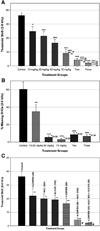Nitrones as therapeutics
- PMID: 18793715
- PMCID: PMC2796547
- DOI: 10.1016/j.freeradbiomed.2008.08.017
Nitrones as therapeutics
Abstract
Nitrones have the general chemical formula X-CH=NO-Y. They were first used to trap free radicals in chemical systems and then subsequently in biochemical systems. More recently several nitrones, including alpha-phenyl-tert-butylnitrone (PBN), have been shown to have potent biological activity in many experimental animal models. Many diseases of aging, including stroke, cancer development, Parkinson disease, and Alzheimer disease, are known to have enhanced levels of free radicals and oxidative stress. Some derivatives of PBN are significantly more potent than PBN and have undergone extensive commercial development for stroke. Recent research has shown that PBN-related nitrones also have anti-cancer activity in several experimental cancer models and have potential as therapeutics in some cancers. Also, in recent observations nitrones have been shown to act synergistically in combination with antioxidants in the prevention of acute acoustic-noise-induced hearing loss. The mechanistic basis of the potent biological activity of PBN-related nitrones is not known. Even though PBN-related nitrones do decrease oxidative stress and oxidative damage, their potent biological anti-inflammatory activity and their ability to alter cellular signaling processes cannot readily be explained by conventional notions of free radical trapping biochemistry. This review is focused on our studies and others in which the use of selected nitrones as novel therapeutics has been evaluated in experimental models in the context of free radical biochemical and cellular processes considered important in pathologic conditions and age-related diseases.
Figures





References
-
- Iwamura M, Inamoto N. Novel formation of nitroxide radicals by radical addition to nitrones. Bull. Chem. Soc. Jpn. 1967;40:703.
-
- Janzen EG, Blackburn BJ. Detection and identification of short-lived free radicals by electron spin resonance trapping techniques (spin trapping). Photolysis of organolead, -tin, and -mercury compounds. J. Am. Chem. Soc. 1969;91:4481–4490.
-
- Janzen EG. Spin trapping. Acc. Chem. Res. 1971;4:31–40.
-
- Harbour JR, Bolton JR. Superoxide formation in spinach chloroplasts: Electron spin resonance detection by spin trapping. Biochem. Biophys. Res. Commun. 1975;64:803–807. - PubMed
-
- McCay PB, Poyer JL, Floyd RA, Fong K-L, Lai EK. Spin-trapping of radicals produced during enzymic NADPH-dependent and CCl4-dependent microsomal lipid peroxidation. Fed. Proc. 1976;35:421.
Publication types
MeSH terms
Substances
Grants and funding
LinkOut - more resources
Full Text Sources
Other Literature Sources
Medical

